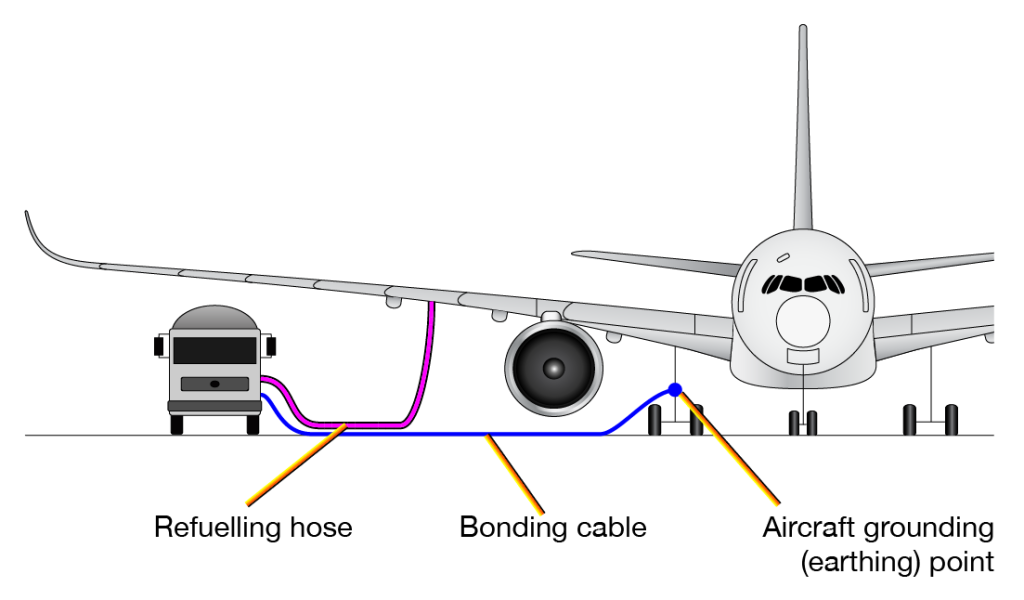
Grounding aircraft while refueling is a process where trained personnel carry out tasks to fill an aircraft with fuel in order to enable the aircraft to continue its journey.
Aircraft refueling is one of the serious tasks carried out by trained aircraft mechanics.
Safe refueling operations require strict adherence to procedures and careful application of the safety precautions, not only by the refueling operators but also flight crew, the cabin crew, and the other ground operators.
This article highlights the safety precautions that need consideration when refueling an aircraft.
Safety checklist
Flight Mechanic notes that taking a long checklist of safety precautions prior to fueling, there are a few precautions that you may not think about right away:
- Ensure all aircraft electrical systems and electronic devices, including radar, are turned off.
- Empty shirt pockets of any items, as they could fall into the fuel tanks.
- Do not fuel aircraft if there is a danger of other aircraft in the vicinity blowing dirt in the direction of the aircraft being fueled.
Checking fuel and oils
The pilot in command of an aircraft shall ensure that the aircraft is not flown unless the:
- The aviation fuel.
- aircraft engine lubricating oil.
- aircraft engine power augmentation fluid.
- The aircraft hydraulic system fluid.
The PIC may assume that the above fluids already on the aircraft comply with the required specification and grade.
All ground fuel stock shall be carefully checked for the presence of undissolved water before commencing the fuelling operation.
The pilot in command must use a positive method, such as suitable water-detecting paste or paper, to test for the presence of free water.
Since sensory perceptions of color and smell, if used alone, can be quite misleading.
AIRCRAFT REFUELING PROCEDURE
There are several steps of aircraft refueling and it starts with the grounding of aircraft and the fuel tanker. Do not drag the hose along the leading edge.
Next, connect the fueling nozzle grounding cable to the aircraft grounding receptacle and immediately remove the filler cap.
After that, insert the fuel nozzle into the filler cap and commence fueling which is carried out by the suction method which is provided by the tanker.
Stop fueling once the desired fuel quantity has been reached. This can be monitored from the cockpit gauge reading.
Once finishing the fueling process, install and secure the filler cap.
Remove the fueling nozzle grounding cable from the aircraft grounding receptacle, the fuel tanker from the aircraft, and the grounding cable from the aircraft as well as from the tanker.
Finally, ensure the fuel does not come in contact with skin, clothes, and eyes.
Immediately clean and wash with water and special soap if this happens and also seek the medical attention.
If there is any spillage of fuel on the ground, clean the spillage.
Bonding and grounding during refueling
Bonding
Bonding ensures electrical continuity between the aircraft and the refueling vehicle, preventing any spark to appear when the ground operator connects the refueling hose to the aircraft coupling.
It is mandatory to bond the aircraft to the refueling vehicle/device before connecting the refueling hose.
One of the aircraft grounding (earthing) points must be used to connect the bonding cable. Depending on the aircraft type, locate the grounding (earthing) points:
- On the Nose Landing Gear (NLG).
- The Main Landing Gears (MLG).
- On the wings.
- The engine air inlet.
- At the High Pressure (HP) connector.
Indicate grounding (earthing) points by a placard to ease their identification.
The type of placard may differ depending on its location and the aircraft type. Examples of placards used for grounding point identification
A cable section of 20 mm² or more is recommended to ensure sufficient bonding. The total electrical resistance of the cable between the A/C and the fuel tanker must not be more than 10 ohms.

Refueling safety zones
As the aviation industry standard, must respect a 3-meter safety zone around the area located under the NACA vents, overpressure protectors, and refuel coupling(s).
These areas must be clear of any object or personnel. Their location can be found in the Refuel Safety procedures of the AMM/AMP/MP.
In addition, an escape corridor must be clear of obstacles so that the refueling vehicle can leave the area in case of an emergency.

REFUELLING WITH PASSENGERS ON-BOARD
Today’s short transit time used by some operators often requires refueling operations while passengers are still -or already- on-board the aircraft.
It is essential for all actors to respect additional safety precautions and require preparation to initiate an emergency evacuation.
Keep ground areas clear for slide deployment
Depending on the ground servicing and catering operations, the area beneath the available exits must be clear to enable proper slide deployment in the case of an evacuation.
Cabin and passengers handling
The flight crew must switch OFF the SEAT BELT signs and switch ON the NO SMOKING signs and inform the cabin crew when the refueling operation starts and ends.
Cabin aisle and curtains
The cabin aisle(s) and exits must be free of obstacles that could impair the evacuation path.
Secure cabin curtains in the open position and the cabin lighting should be ON.
Cabin Crew
The cabin crew must inform passengers that a refueling operation is ongoing and that they must not fasten their seatbelts to ease evacuation in the case of an emergency.
Each cabin crew should prepare for an evacuation and at least one cabin crew member should be positioned at each door pair.



